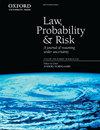‘This Crime is Not That Crime’—Classification and evaluation of four common crimes
IF 1.4
4区 社会学
Q1 LAW
引用次数: 1
Abstract
As the basis of criminal penalty, criminal conviction, integral to the protection of fundamental rights and freedom of people constitutes the basis and the core issue of criminal trials. Based on the data published on China Judgments Online, we proposed two types of classification models to apply the data of four common crimes from China Judgments Online and expounded their applications in identifying ‘abnormal cases’, defined as wrongly sentenced cases in this article. The two types of classification models we proposed are a two-stage model and two deep learning models. To construct the two-stage model, we first used three keyword-extraction models to extract the keywords and vectorize all the keywords, then used five classification models to build the two-stage model. For the deep learning models, we applied two different deep neural network models in the data to build the classifier. We then applied these two types of classification models to discover ‘abnormal cases’ in two steps. In the first step, we applied the two-stage model to extract the ‘important words’ which will significantly improve the probability of the two-stage model to classify cases into crimes of intentional injury. In the second step, we constructed a validation data set of cases whose verdicts are changed in the second instance rulings to test the ‘important words’ extracted in first step and the ability of the two-stage model and the two deep learning models to discover ‘abnormal cases’. The results of this exercise show that: (1) ‘important words’ extracted in the first step are often associated with ‘abnormal cases’; (2) these two types of classification models can effectively discover ‘abnormal cases’, but compared with the two deep learning models, the two-stage model (aka. Term Frequency-Inverse Document Frequency and Artificial Neural Network, the combination of a keyword extraction model and a classic machine-learning model) is more capable of discovering ‘abnormal cases’.“本罪非彼罪”——四种常见犯罪的分类与评价
刑事定罪作为刑事处罚的基础,是保护人民基本权利和自由的组成部分,是刑事审判的基础和核心问题。基于中国判决网上公布的数据,我们提出了两种类型的分类模型来应用中国判决网上四种常见犯罪的数据,并阐述了它们在识别“异常案件”(本文定义为错判案件)中的应用。我们提出的两种类型的分类模型是两阶段模型和两种深度学习模型。为了构建两阶段模型,我们首先使用三个关键词提取模型来提取关键词并对所有关键词进行矢量化,然后使用五个分类模型来构建两阶段模式。对于深度学习模型,我们在数据中应用了两种不同的深度神经网络模型来构建分类器。然后,我们应用这两种类型的分类模型分两步发现“异常病例”。在第一步中,我们应用两阶段模型提取“重要词语”,这将显著提高两阶段模型将案件归类为故意伤害罪的概率。在第二步中,我们构建了二审裁决中判决发生变化的案件的验证数据集,以测试第一步提取的“重要词语”以及两阶段模型和两个深度学习模型发现“异常案件”的能力。该练习的结果表明:(1)第一步提取的“重要单词”通常与“异常情况”相关;(2) 这两种类型的分类模型可以有效地发现“异常案例”,但与这两种深度学习模型相比,两阶段模型(即术语频率逆文档频率和人工神经网络,关键字提取模型和经典机器学习模型的结合)更能发现“异常病例”。
本文章由计算机程序翻译,如有差异,请以英文原文为准。
求助全文
约1分钟内获得全文
求助全文
来源期刊

Law Probability & Risk
MATHEMATICSSTATISTICS & PROBABILITY&-STATISTICS & PROBABILITY
CiteScore
2.10
自引率
28.60%
发文量
8
期刊介绍:
Law, Probability & Risk is a fully refereed journal which publishes papers dealing with topics on the interface of law and probabilistic reasoning. These are interpreted broadly to include aspects relevant to the interpretation of scientific evidence, the assessment of uncertainty and the assessment of risk. The readership includes academic lawyers, mathematicians, statisticians and social scientists with interests in quantitative reasoning.
The primary objective of the journal is to cover issues in law, which have a scientific element, with an emphasis on statistical and probabilistic issues and the assessment of risk.
Examples of topics which may be covered include communications law, computers and the law, environmental law, law and medicine, regulatory law for science and technology, identification problems (such as DNA but including other materials), sampling issues (drugs, computer pornography, fraud), offender profiling, credit scoring, risk assessment, the role of statistics and probability in drafting legislation, the assessment of competing theories of evidence (possibly with a view to forming an optimal combination of them). In addition, a whole new area is emerging in the application of computers to medicine and other safety-critical areas. New legislation is required to define the responsibility of computer experts who develop software for tackling these safety-critical problems.
 求助内容:
求助内容: 应助结果提醒方式:
应助结果提醒方式:


